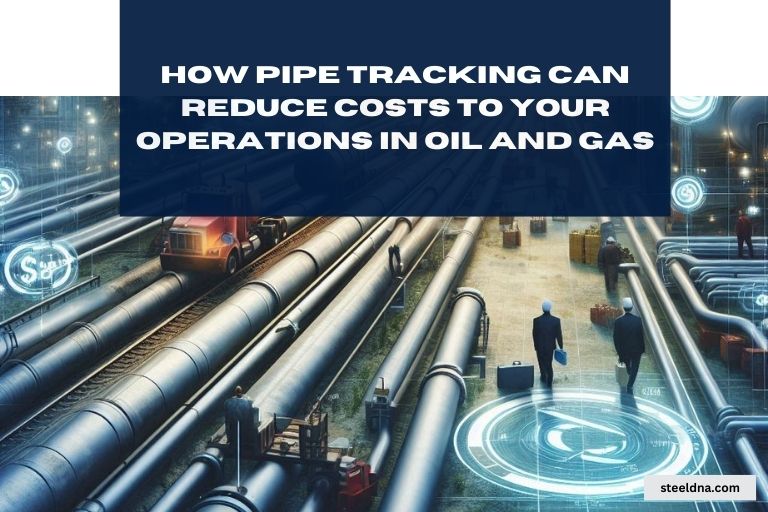Introduction
In oil and gas operations, ensuring the seamless flow of resources from extraction to distribution hinges on the ability to trace pipelines accurately and monitor their performance diligently. Traditionally, this has been a daunting task, fraught with challenges arising from the sheer scale of operations and the complexity of the infrastructure involved. However, the advent of data analytics has ushered in a new era, offering unprecedented opportunities to expound upon traditional methods and revolutionize pipeline management.
Understanding Pipe Traceability
- Definition and Significance- Pipe traceability involves the systematic documentation and tracking of pipes from manufacturing to installation and beyond. The significance of traceability cannot be overstated, as it facilitates efficient maintenance, compliance with regulations, and swift response to any operational challenges.
- Challenges with Traditional Methods- Traditional methods of pipe tracking often present various challenges, such as manual record-keeping, which is prone to errors and inefficiencies. Moreover, relying solely on paper-based documentation can lead to delays in identifying pipe origins, specifications, and maintenance history. These challenges underscore the need for more robust and automated traceability solutions to meet the demands of modern pipeline operations.
- Importance of Accurate Traceability- Accurate traceability serves as the backbone of pipeline integrity and safety. By knowing the exact specifications, materials, and history of each pipe segment, operators can ensure compliance with industry standards and regulatory requirements. Furthermore, in the event of a pipeline incident or maintenance issue, precise traceability enables swift and targeted responses, minimizing downtime and potential risks to personnel and the environment.
The Need for Performance Monitoring
- Explanation of why performance monitoring is critical in oil and gas pipelines- By continuously monitoring performance metrics such as flow rates, pressure levels, and temperature variations, operators can swiftly identify anomalies or potential issues within the pipeline infrastructure. This proactive approach allows for timely intervention to prevent costly downtime, mitigate safety hazards, and maintain regulatory compliance.
- Key performance indicators (KPIs) for evaluating pipeline performance- Key performance indicators (KPIs) serve as essential benchmarks for evaluating the efficiency and effectiveness of pipeline operations. Metrics such as throughput capacity, corrosion rates, and leak detection accuracy provide actionable insights into the health and performance of the pipeline system. By establishing clear KPIs and regularly monitoring them, operators can identify areas for improvement, optimize resource allocation, and enhance overall operational performance.
- How performance monitoring enhances operational efficiency and reduces downtime- Performance monitoring plays a pivotal role in optimizing operational efficiency and minimizing downtime in oil and gas pipelines. By proactively monitoring performance metrics in real-time, operators can detect potential issues before they escalate into costly disruptions. Timely intervention, guided by actionable performance data, enables swift resolution of operational challenges, thereby maximizing uptime and ensuring continuous product flow. Additionally, by identifying trends and patterns through ongoing performance monitoring, operators can implement proactive maintenance strategies to prolong asset lifespan and minimize unplanned shutdowns.
Introduction to Data Analytics
- Explanation of data analytics- Data analytics involves analyzing vast amounts of data to uncover meaningful insights and patterns. By utilizing advanced algorithms and statistical techniques, data analytics enables organizations to extract valuable information from their data, leading to informed decision-making and improved performance.
- Overview of different types of data- In pipeline management, various types of data are utilized, including sensor data collected from equipment and infrastructure, historical data regarding past incidents and maintenance activities, and operational data such as flow rates and pressure levels. Each type of data provides unique insights into pipeline operations and performance.
- Importance of real-time data analytics- Real-time data analytics plays a crucial role in pipeline management by providing up-to-the-minute insights into the condition and performance of pipelines. By analyzing data as it is generated, operators can quickly identify potential issues, optimize operations, and make proactive decisions to prevent downtime and ensure the safety and reliability of their pipelines.
Enhancing Pipe Traceability with Data Analytics
- Improving Manufacturing Processes- Data analytics optimizes manufacturing workflows, ensuring seamless production of pipes while maintaining quality standards. By analyzing production data in real-time, manufacturers can identify and address inefficiencies promptly, resulting in higher-quality pipes with accurate traceability from the outset.
- Streamlining Supply Chain Management- Leveraging data analytics, oil and gas companies can track the movement of pipes throughout the supply chain. This enables proactive management of inventory levels, timely deliveries, and effective coordination between suppliers and manufacturers. By streamlining the supply chain, companies can minimize delays and ensure the availability of pipes when needed for installation.
- Enhancing Installation Tracking- Data analytics facilitates precise tracking of pipe installation activities, allowing project managers to monitor progress and adherence to schedules. Real-time analytics enable the identification of potential bottlenecks or deviations from plans, empowering managers to take corrective actions promptly. This ensures that pipes are installed correctly and according to specifications, enhancing overall traceability and project efficiency.
- Implementing Asset Tagging Solutions- Utilizing data analytics, oil and gas companies can implement advanced asset tagging solutions, such as RFID tags or barcodes, to uniquely identify and track individual pipes. These tags are linked to digital databases containing detailed information about each pipe, including manufacturing specifications, inspection records, and maintenance history. By scanning these tags throughout the pipe's lifecycle, operators can maintain accurate traceability and access essential data instantaneously.
Performance Monitoring through Data Analytics
- Real-Time Monitoring for Proactive Maintenance- Data analytics enables real-time monitoring of pipeline performance, empowering operators to detect anomalies and potential issues before they escalate. By continuously analyzing data from sensors and other sources, operators can identify trends and patterns indicative of impending failures or inefficiencies. This proactive approach to maintenance minimizes downtime and reduces the risk of costly disruptions to operations.
- Predictive Analytics for Anticipating Failures- Leveraging predictive analytics, operators can forecast potential failures based on historical data and current operating conditions. Advanced algorithms analyze various factors such as pressure, temperature, flow rates, and corrosion levels to predict when equipment or components are likely to malfunction. By anticipating failures in advance, operators can schedule maintenance activities strategically, optimizing resources and maximizing asset uptime.
- Visualizations and Dashboards for Actionable Insights- Data analytics tools generate visualizations and dashboards that provide operators with actionable insights into pipeline performance. These intuitive interfaces present complex data in a comprehensible format, enabling operators to quickly identify trends, anomalies, and areas for improvement. By visualizing performance metrics such as throughput, pressure gradients, and equipment health status, operators can make informed decisions to optimize pipeline operations and ensure regulatory compliance.
Overcoming Challenges and Considerations
- Addressing Implementation Hurdles- Implementing data analytics for pipe traceability and performance monitoring can present various challenges. These include integrating disparate data sources, ensuring compatibility with existing systems, and overcoming resistance to change among stakeholders. By fostering clear communication, providing comprehensive training, and actively involving key personnel in the implementation process, organizations can effectively address these hurdles.
- Ensuring Data Accuracy and Reliability- One of the primary concerns when utilizing data analytics in pipeline management is ensuring the accuracy and reliability of the data being analyzed. Factors such as sensor malfunctions, data entry errors, and inconsistencies in data formats can undermine the effectiveness of analytics efforts. To mitigate these issues, organizations must establish robust data validation processes, regularly calibrate sensors, and implement quality control measures throughout the data collection and analysis pipeline.
- Navigating Regulatory and Compliance Challenges- The oil and gas industry is subject to stringent regulatory requirements and compliance standards, which can pose challenges when implementing new technologies like data analytics. Organizations must ensure that their data analytics initiatives comply with industry-specific regulations, data privacy laws, and environmental regulations. This may involve engaging with regulatory bodies, conducting thorough risk assessments, and implementing appropriate safeguards to protect sensitive data and mitigate legal risks.
- Managing Security Risks- With the increasing digitization of pipeline management processes, cybersecurity has become a critical concern. Data breaches, cyberattacks, and unauthorized access to sensitive information can have severe consequences for pipeline operators, including operational disruptions, reputational damage, and financial losses. To safeguard against security risks, organizations must implement robust cybersecurity measures, such as encryption, access controls, intrusion detection systems, and regular security audits, to protect their data assets and infrastructure from potential threats.
- Ensuring Scalability and Sustainability- As organizations scale up their data analytics initiatives to encompass larger datasets and more complex analytics tasks, they must ensure that their infrastructure, resources, and processes can support sustained growth. This may involve investing in scalable cloud computing solutions, adopting agile development methodologies, and fostering a culture of continuous improvement and innovation. By prioritizing scalability and sustainability from the outset, organizations can future-proof their data analytics capabilities and drive long-term value from their investments.
Future Trends and Innovations
As technology continues to advance, new challenges and considerations arise in implementing data analytics for pipe traceability and performance monitoring. One key challenge is ensuring data security and privacy, especially as more sensitive information is collected and analyzed. Additionally, compliance with industry regulations such as GDPR and HIPAA adds another layer of complexity to data management practices.
Overcoming these challenges requires a proactive approach, including robust encryption protocols, regular audits, and ongoing staff training to maintain awareness of evolving threats. Furthermore, collaboration between industry stakeholders, government agencies, and cybersecurity experts will be crucial in developing standardized best practices for data protection in pipeline management.
By addressing these challenges head-on, organizations can maximize the benefits of data analytics while safeguarding sensitive information and maintaining compliance with regulatory requirements.
Conclusion
Data analytics plays a pivotal role in enhancing pipe traceability and performance monitoring within the oil and gas industry. By harnessing the power of data analytics, companies can achieve greater accuracy in tracking pipelines throughout their lifecycle and gain valuable insights into their performance in real-time. This proactive approach enables timely decision-making, reduces downtime, and enhances overall operational efficiency. As technology continues to advance, the integration of data analytics will undoubtedly become even more vital, shaping the future of oil and gas pipeline operations.
Popular Articles
Expand your knowledge with these insightful blog posts.

The Economic Benefits of Coil Tracking in Oil and Gas

How Pipe Tracking Can Reduce Costs to your Operations in Oil and Gas

Predictive Maintenance with Coil Tracking: Reducing Downtime and Costs
Subscribe to our Blog
Welcome to our blog! Stay updated with the latest industry trends, tips, and insights. Subscribe now to never miss a post or contact us for collaborations and guest post opportunities.

.jpg)